‘Behemoth’ is a word which springs to mind or, perhaps more nautically, ‘leviathan’.
- Aesthetics
- Performance
- High quality build and engineering
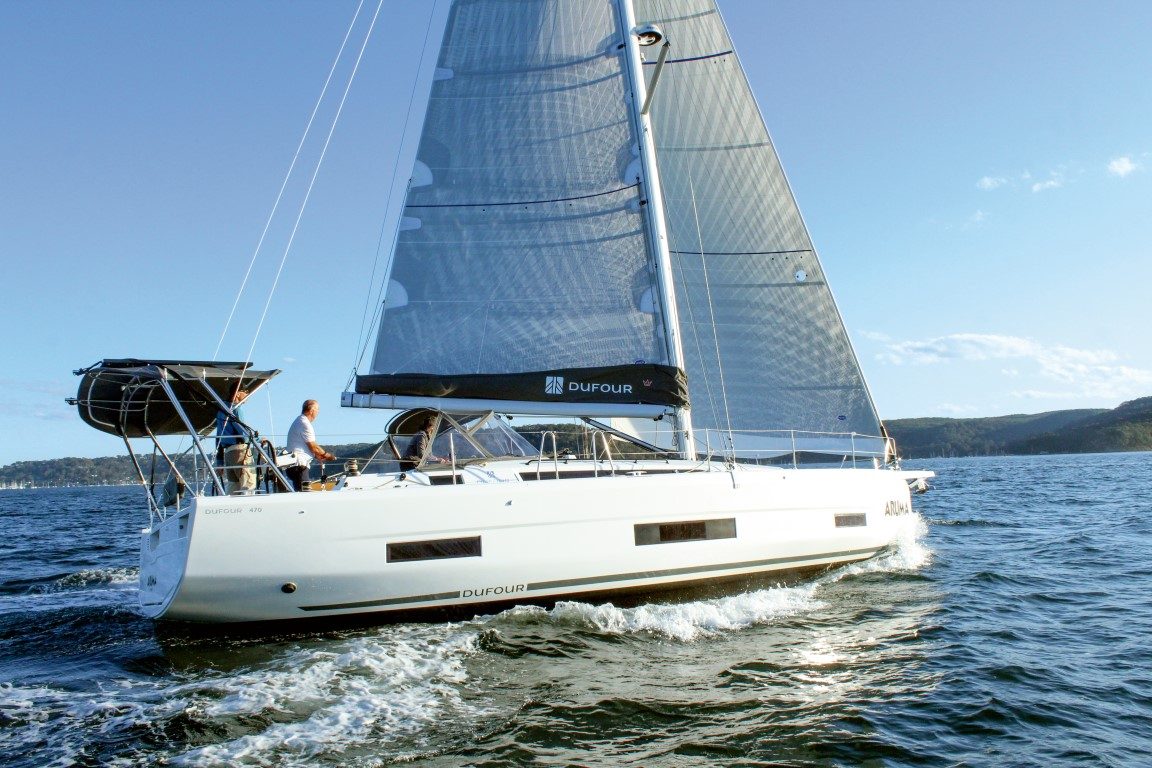
Nothing is more enjoyable to windward than a deep-keeled monohull with a good suit of sails, something our Australian correspondent Kevin Green was reminded of during a coastal voyage on the new Dufour 470.
The Dufour 470 made its Australian debut at the 2021 Sanctuary Cove Boat Show, supplied by Multihull Solutions through the dealership Yacht Sales Co. Since then, six of these cruisers have been imported into Australia and the first 470 is due in New Zealand in April 2023.
After an enjoyable coastal sail on hull #48, I can clearly see the attraction. The La Rochelle-based builder’s nine-boat range goes from 31 foot to the flagship 61-footer. Under founder Michele Dufour, the yard was known for performance cruisers, but now owned by Fountaine Pajot, it specialises in general cruising yachts, designed by Italian Umberto Felci since 2003.

Customisation
The Dufour 470 is available in three versions: Ocean, Performance and Easy. The base price for the Ocean is AUD$724,500.
Our review boat was an Ocean version with traditional sail handling – slab reefing, winches on the coamings and mainsail sheeting near the helm. Alternatively, aspiring regatta participants can opt for the deeper-keeled Performance version with better capabilities to windward, six winches and transom location of the mainsail track. The Easy suits charters and short-handed sailors, with a self-tacking jib, in-mast furling and saloon-mounted mainsheet.
The review boat had locally-cut Hood sails, carbon EM2 versions that set beautifully bent on a Z-Spars alloy mast with wire shrouds and double backstay.
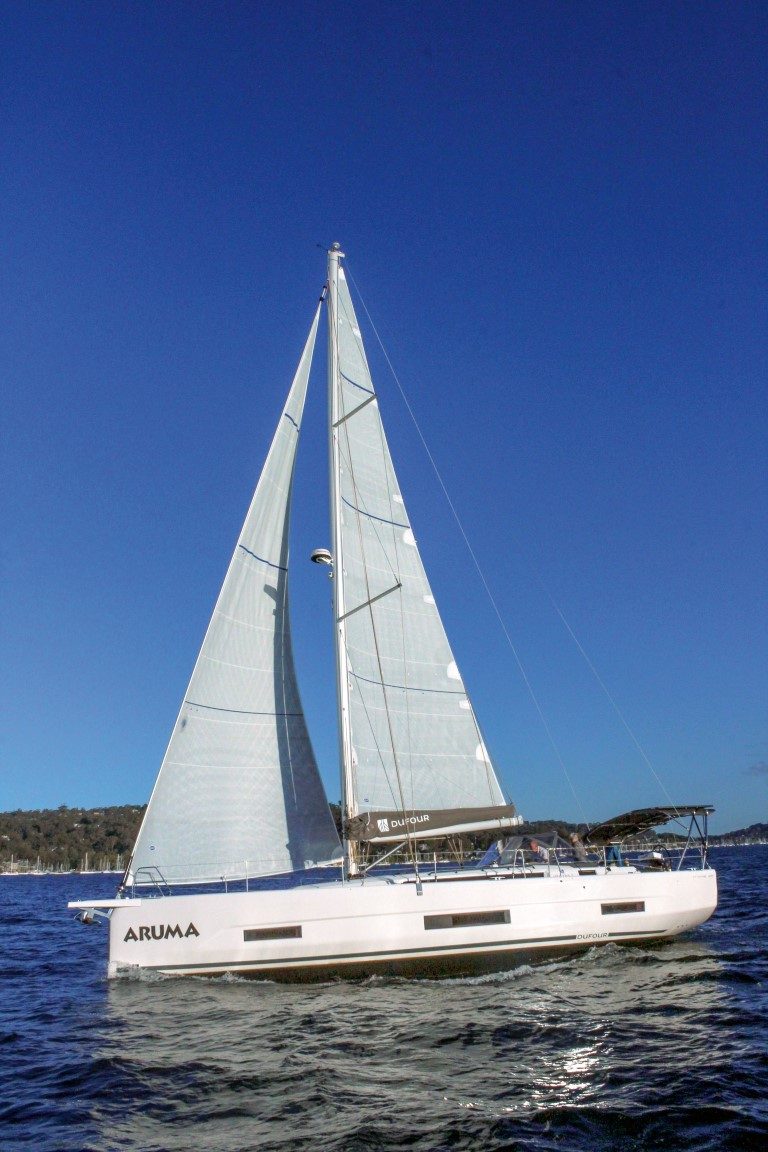
Looking over hull #48 at Sydney’s Middle Harbour Yacht Club before we cast off, there was plenty to enjoy. A cruising yacht’s cockpit should be a versatile space because it must function both at sea and at rest, something Italian designer Felci clearly understands. The large, wide, teak-clad cockpit is divided into a central relaxing area with sail controls aft and on the coachroof.
On the starboard binnacle the throttle is prominently placed along with controls for the retractable bow thruster which gives a clean hull profile. The diameter of the twin composite steering wheels is just right whether standing upright or sitting outboard with the foot plates deployed when heeled over. The ignition is conveniently placed beside the Raymarine plotter with autopilot screen and rev counter for the 75hp saildrive, all easily viewable.

Good features abound in the cockpit: ample space between the twin binnacles for walking, plus access to the rudder shaft for emergency steering (with tiller supplied). At sea, the elongated cockpit table is a useful brace and can house a fridge with storage, with wide fold-out teak wings and a larger Raymarine screen at its back. Our review boat was offshore-ready thanks to a spray hood and a bimini (with 1,200W worth of solar panels) protecting the cockpit and a hinged swim platform for easy water access. The main hatch has the fashionable saloon-style doors, rather than my preferred sliding washboards, but that is really the only blemish in the 460’s cockpit.
Open plan saloon
The open-plan saloon arrangement has the modern finish European yachts excel at. The floor plan is intended for utility both offshore and at anchor, but there are compromises such as a lack of handholds, especially a desirable longitudinal roof handrail. There is a spacious dinette lounge with surrounding seating for about eight, plus the bench seat with sumptuous cushioning on the port side. The galley can be positioned forward – as on our boat – or longitudinally mid-ships.
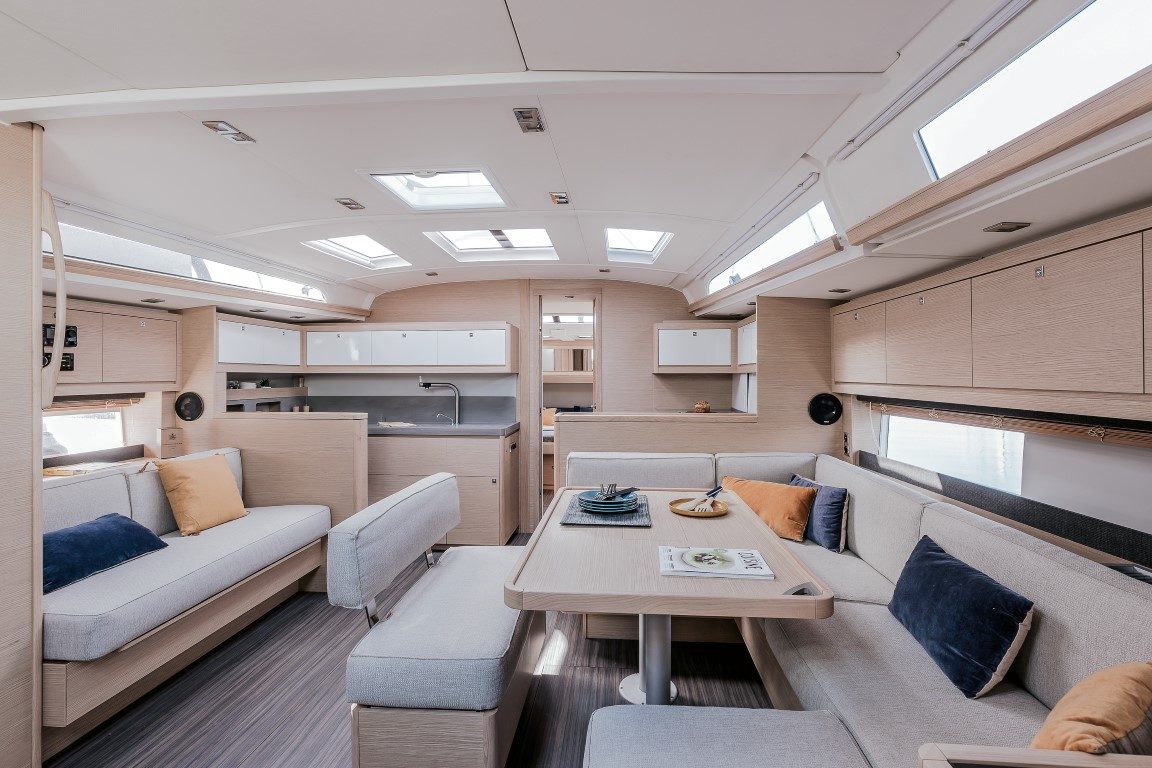
Galley forward is popular on larger yachts, taking advantage their wide beam to create a substantial athwartships cooking space with plenty surrounding bulkheads for whitegoods (including washer-dryer). The 470 is a very good example of this. Surrounded by overhead locker space, double fridge-freezer and lots of worktop area, the galley easily allows two crew to prepare food. Traditionalists may discount this large yacht feature, but it leaves the entire aft saloon free for entertaining, plus a corner chart table where navigation electronics could be housed on the bulkhead.
Four cabins
Accommodation layouts include a large V-berth and two double berths aft, as reviewed. As you’d expect from this high-volume hull, up to four cabins can have ensuites, which is ideal for the charter market. Alternatively, dedicated cruising sailors may choose the three-cabin, two-head version seen here.
Notable features include ample natural light from portlights, saloon windows and large skylights throughout the hull. The pale wood finish further brightens the layout, including around the forward galley.

At sea, the aft berths are the most comfortable, but European-style (stern-to) mooring often sees the large V-berth used to give the owner more privacy. Here, the queen-sized bed has separate memory foam mattresses, access on both sides and storage underneath.
Headroom is generous thanks to the tall topsides, so there’s plenty of space for lockers and shelves. Ventilation and natural light are also superb, especially with the rectangular forward-facing skylight. Also good is the separate shower and head, split either side of the V-berth. You can even specify a small crew berth with ablutions in the bow.

The two symmetrical double cabins aft retain sufficient volume, despite being under the cockpit, and they have the second bathroom nearby as well. Again, locker space is generous and there’s ample natural light from the elongated portlights.
Strong aesthetics
Strong aesthetics are a feature of all Felci-designed Dufours, characterised by upright hulls to accommodate high-volume interiors and low-profile deck saloons. The vast beam (15.5 ft) is carried to the transom to further maximise volume, increase form stability and create a wide planing area for downwind speed, with hard chines giving linear stability. A major upside of the wide hull is only modest heeling angles, which improves life aboard under sail. Engine access is via the lifting companionway with the machinery space conventionally laid-out with access to all service points on the Volvo 75hp diesel.
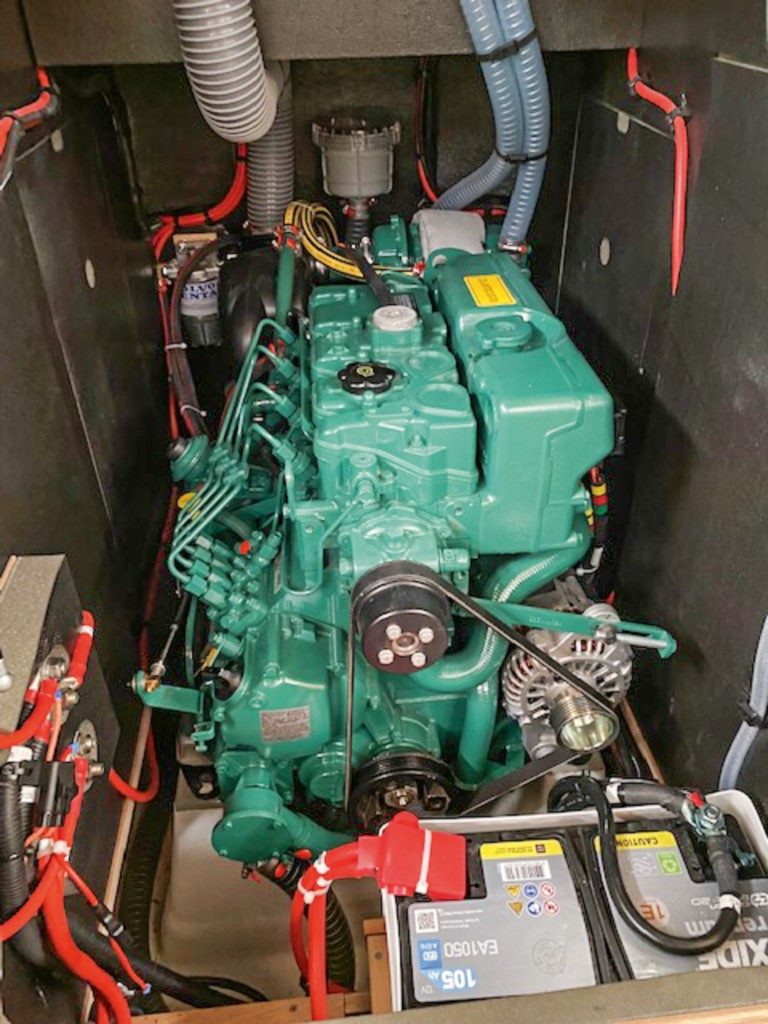
The resin-infused foam-cored vinylester hull has long hard chines aft and deep forward sections with a contemporary snub bow and vertical transom, to maximise the 48-foot waterline. The deck is injection-moulded foam, for insulation and weight-saving. There’s a single deep spade rudder on a stainless shaft and a saildrive gearbox. Ballast is an L-shaped cast iron keel which won’t snag when coastal cruising – something the 470 looks eminently suited for. The ballast ratio is modest at only 26.9%, but like many modern designs, stability comes from the wide beam and hull volume, while a sail area-displacement ratio (SAD) of 19.5 puts the 470 in the moderately weighted cruiser class.
Coastal cruise
Casting off from the marina in Sydney was done without drama thanks to the drop-down Side Power thruster pushing the tall topsides against the side-breeze. On the wheel was new owner Tom, wife Janice as crew, and our host for the day, Bob Vinks from The Yacht Co.
Once clear and motoring away from the pontoon, the 75hp Volvo showed its mettle, pushing us to seven knots at 2,500rpm and no vibration felt from the folding propeller. Pointing into the wind, the electric Lewmar winch made short work of hoisting the Hood mainsail, via the lazyjacks and we surged off towards Sydney Heads for our coastal passage north. Similarly, with the genoa on its tape furler – a smoother system than the drum version – it rolled out seamlessly.
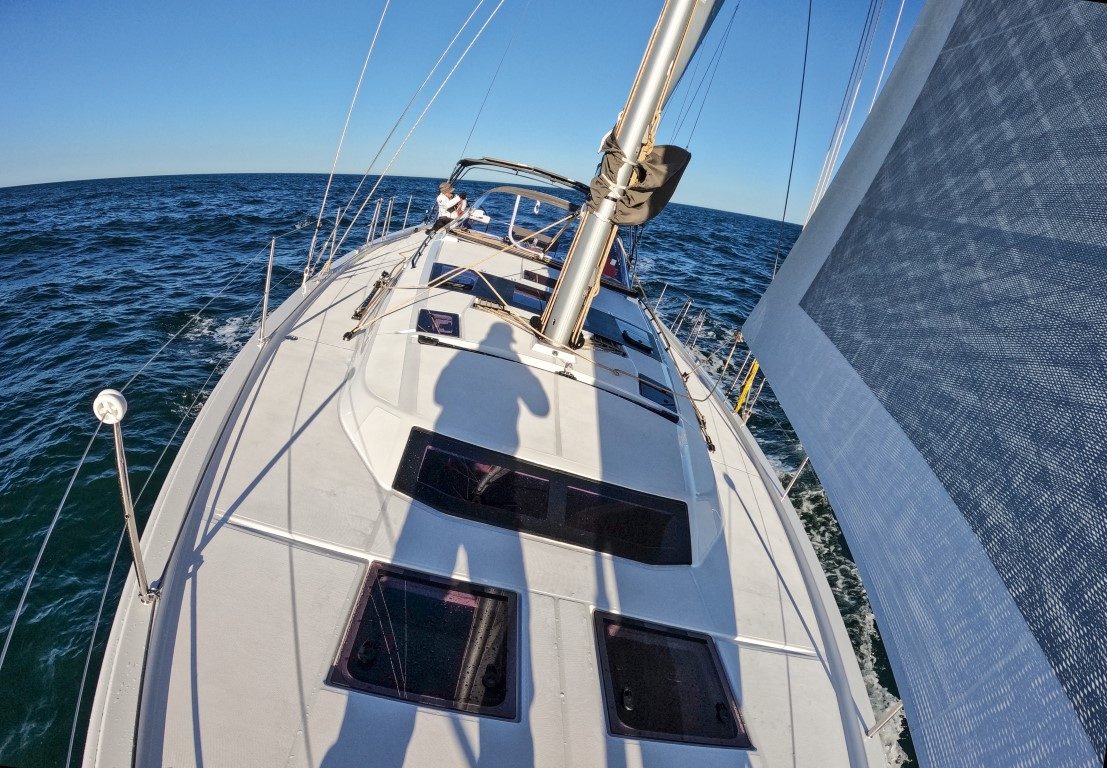
Many Sydney boaters never venture beyond the heads, and given the lovely sailing in these enclosed waters, I can appreciate this. However, the more adventurous do and their first test is the surging southerly swell that becomes confused at the harbour entrance. They are a reminder to batten all hatches, close the doors and stow gear.
We did some of that on the 470, but there were no structural groans – thanks to features such as glassed-in bulkheads and a solidly laid-up hull. As the metre-plus swell met our blunt bow there was the inevitable crash landing and spray over the foredeck, but the deep cockpit and sprayhood protected us well. Setting up for a tack was easily done with generous space around the jib sheet winches and the German mainsheet allowed control from both sides, the rig easily managed by its mainsheet track on the cabin top.

Tacking through about 100 degrees, we made our way north, punching against the wind and the infamous East Australian Current (EAC); but it proved an enjoyable experience as the predictable roll of the 470 allowed us all to settle into a rhythm. I sail dozens of boats on an annual basis, and each one is built for a purpose – something I remind myself of often because that’s how one judges a boat. This Dufour 470, hull number 48, aims to be a general cruising yacht which it eminently succeeds at, as it will in its Easy version, which has simple sail controls on top of an equally comfortable accommodation layout. However, in Performance guise, perhaps not quite so, given the weight and volume. But that is supposition and perhaps slightly unfair – especially since our premium regatta at Hamilton Island is now largely made up of these ‘compromised cruisers’ providing plenty of enjoyment on the race track.
On the helm offshore from Sydney, I easily reduced the pressure from the deep spade rudder by judicious use of the sheets. Then I relaxed by sitting on the gunwale with seaboots comfortably placed on the lifting footplate. So, with an easy grip on the composite wheel and clear view of the tell-tales on both genoa and mainsail, it was a most enjoyable experience. However, there was a competition to be won. Owner Tom had managed about seven knots approaching Long Nose Point, which was midway to our destination of Pittwater. So, my aim was to outdo him.

With the sometimes-fickle breeze, but flatter water than Tom had just beyond the point, I reached 8.9 knots hard on the breeze at 42 degrees in 19 knots of true wind – very impressive and in a large part due to the excellent Hood EM2 sails.
As I’ve said before, nothing is more enjoyable to sail to windward than a deep-keeled monohull, but I should add that one with the refinement levels of this Dufour 470 doubles that enjoyment. As they say in La Rochelle, Tres bon, mon ami!/>
‘Behemoth’ is a word which springs to mind or, perhaps more nautically, ‘leviathan’.
White Pointer has earned the respect of discerning customers in New Zealand and Australia, attracting a loyal and ever growing following for its high-quality, rugged and totally dependable aluminium trailer boats.
The hardtop SP635 shares the same underpinnings as the popular SF 635 which was a completely new model back in 2020.
The pride and joy of a multi-generational family, Bliss resides on a pier that’s home to a couple of other Elite motor launches – Sandspit Marina is a hot-spot for the Bill Upfold-designed vessels, with several calling this small marina home.